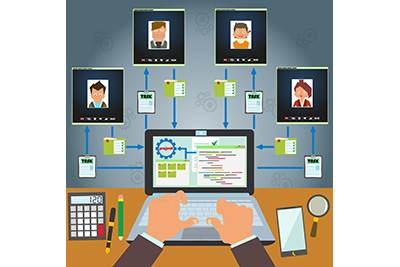While remote work is the norm for many across the globe (43% of workers, in fact), the rest of us are relatively unaccustomed to this lifestyle. Figuring out how to be just as productive at home as you are in the office can be a huge adjustment. So as a manager, how do you continue to lead your team to success while working remotely?
Define Expectations
First and foremost, employees must understand that business should proceed as usual. Whether you have one employee or your entire team working remotely, make expectations crystal clear from day 1. This may include:
- Timing: While employees should continue working their standard office hours, it’s important to reiterate to your team when you expect them to be “online” each morning (actively working and reachable) and when they should expect to log off. If they have appointments during the day, how should they notify you? Update their calendar? Should they set a status in Slack or Google Chat? Is there a designated lunch hour, or should employees be marking that somewhere?
- Deadlines: What work should be completed each day, week, and month, and how will tasks be submitted and reviewed? If new projects come up, what’s the best way to assign them and communicate all associated responsibilities? What happens if an employee misses a deadline or needs an extension?
- Meetings: Advise your employees that all calls and meetings should happen as scheduled. Meetings shouldn’t be canceled but rather transitioned to phone or video. Productivity should never slow down because a remote worker isn’t in the office! Online meetings, especially video meetings, can be just as effective as in-person conversations.
Over-Communicate
Because you’re not a few desks down from your coworkers or manager, it’s your job to remain in contact with your team, share updates throughout the day, and frequently check in. We recommend scheduling daily (or twice daily!) check-ins with your remote employees.
Next, determine the best strategy for connecting—whether it’s a Google Hangout or using a videoconferencing software. Whatever you choose, we highly recommend video communication instead of the phone. Little things like eye contact and facial expressions can really make or break a meeting’s effectiveness.
Come prepared to each meeting with specific items to cover, and show up on time. When working remotely, your team members can’t tap you on the shoulder to remind you to be somewhere. It’s your job to show up on time, and if something comes up or you’re delayed, communicate quickly.
How do we stay connected as a remote team at Vettery? Standups! All of our teams conduct two standups (status updates) each day during which employees set clear goals for themselves at the beginning of the day and communicate what they’ve accomplished by the end of the day. Generally, we use the following prompts to structure our standups:
Beginning of day:
- What are your top three priorities for the day?
- What other items or projects are you working on?
- Any big meetings or other events planned?
- Is there anything you need from your manager/teammates today?
End of day:
- What were you able to accomplish today?
- What didn’t get done? Why?
- Did you encounter any issues while working remotely today?
- As you’ve been working remotely, are there any items (equipment, software, access, etc.) you feel you need to be more efficient/productive?
Build Trust
As a manager, you have to trust that your employees will continue performing outside of the conventional work environment. Once you define expectations and master communication, leave the rest up to your employees. If your team feels micromanaged, they’ll feel less motivated to complete assigned tasks efficiently and diligently. Trusting your team will gain you more respect and result in more productive work!
If an employee is not performing while working remotely, confront the issue head-on. Ask specific questions about why he or she hasn’t been able to meet deadlines or communicate effectively.
Be Available
Remind your team that while they may not be able to pop over to your desk with quick questions or concerns, you are still fully reachable while remote. Offer to hop on the phone or video chat whenever anything comes up—(over)communication is key! Employees want to trust that you’re still there as a resource and that they have someone supporting them outside the office.
| Samantha Friedman is the Senior Vice President of People Strategy at Vettery. Sam currently specializes in developing and leading HR teams in the areas of employee relations, employee engagement, strategy & people analytics, talent acquisition, and performance management. Prior to joining Vettery, she developed the HR Strategy and People Analytics function for Penguin Random House. |

